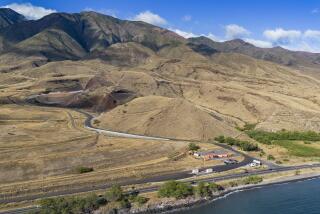Hanford to Begin Shipping Radioactive Waste Off-Site
YAKIMA, Wash. — The nation’s most contaminated nuclear site will for the first time send radioactive waste off the Hanford reservation, beginning next week with shipments to an underground dump in the salt beds of southeastern New Mexico.
Thirty-three 55-gallon drums filled with clothing, tools and debris are scheduled to begin the 1,800-mile trip from south-central Washington on Monday and arrive at the federal Waste Isolation Pilot Project near Carlsbad, N.M., on Wednesday.
“It’s a permanent solution, at least for our side of it. There’s always New Mexico’s side of the story,” said the Department of Energy’s Mark French.
It is estimated that cleaning up the legacy of radioactive and hazardous waste from Hanford’s four decades of plutonium production will cost $55.6 billion and take 46 more years, according to recent DOE figures.
But is dispatching radioactive waste to other states the best way to clean up Hanford?
“We’ve always said that the state of Washington agreed to be part of the solution as long as we weren’t expected to take everybody else’s waste,” said Mike Wilson, manager for the nuclear waste program in the state Department of Ecology. “There’s kind of a fair share aspect to this.”
Right now, Hanford is designated by DOE to take additional low-level and mixed low-level radioactive waste from other parts of the country. And it’s got plenty of waste to store on its own, from spent nuclear fuel from the crumbling K-Basins to the eventual glassification of tank wastes.
“We’ve always expected that Hanford would do its part and the state of Washington would do its part, but not take on the entire burden for the country,” Wilson said.
In Albuquerque, Don Hancock doesn’t believe the solution lies in moving radioactive waste around.
“It doesn’t really accomplish anything except waste a lot of money at a minimum,” said Hancock, director of the nuclear waste safety program for the Southwestern Research and Information Center, a private organization that works on environmental and natural resource issues.
“In the case of Hanford, it seems to me and a number of folks in Washington state that wasting this money is taking away money from more important programs at Hanford,” Hancock said. “That’s not unique to Hanford. It’s happening at other sites.”
New Mexico’s WIPP, which opened in March 1999, has accepted 58 shipments from three locations in the nation’s nuclear weapons complexes: 37 from the closed Rocky Flats nuclear plant near Denver, 17 from Los Alamos National Laboratory and four from the Idaho Engineering and Environmental Laboratory near Idaho Falls.
The waste is buried 2,150 feet underground in rooms excavated from an ancient salt formation.
Hancock questions the safety of using WIPP for permanent storage, noting that it’s one of the most active oil and gas production and exploration areas in the country.
“We believe that even in the next few decades there could be significant problems with the site because of water flooding in the oil industry,” he said.
He also questions the structural integrity of the rooms being used to store the waste.
But retired engineer Milton Levenson of Menlo Park, Calif., a member of the National Academy of Engineering who sits on the National Research Council’s committee on WIPP, believes a geological repository is probably the best ultimate disposal option for nuclear waste.
“What you really want to do is minimize risks,” he said. “There are risks with everything we do. Of all the alternatives that are practical, how does geological repository stack up?”
The greatest risk is most likely in the form of traffic accidents--”not that there will be any radioactive release”--but from a crash itself, he said.
“If you send thousands of trucks out on the highways, sooner or later you’re going to kill a few people,” he said.
Getting radioactive waste away from the Columbia River, where it can leach, and below ground where people can’t stumble onto it, seems to be the best option, he said.
The waste to be moved from Hanford is currently stored in the central area of the 560-square-mile reservation, where plutonium was made for the country’s nuclear arsenal from World War II until the 1980s.
About 2,500 shipments of transuranic waste--the equivalent of 80,000 to 100,000 55-gallon drums--will leave Hanford over the next 30 to 35 years, said French, transuranic waste program manager for DOE in Richland, 10 miles south of Hanford.
“It’s waste that requires a higher degree of isolation from the environment because it has a longer half-life,” French said.
Transuranic waste has a half-life of 20 years or greater, which means it takes 20 years for it to lose half its radioactivity.
The waste moving to WIPP has been specially packaged and will be placed in shipping casks bolted to a trailer.
The waste was packaged in the mid-1990s from the Plutonium Finishing Plant. Preparation includes X-rays, real-time radiography and visual examinations.
Transuranic waste was generated both in producing plutonium at Hanford and in the environmental cleanup that began after the Cold War ended. After 1970, the transuranic waste was required to be placed in retrievable storage rather than buried.
More to Read
Sign up for Essential California
The most important California stories and recommendations in your inbox every morning.
You may occasionally receive promotional content from the Los Angeles Times.










